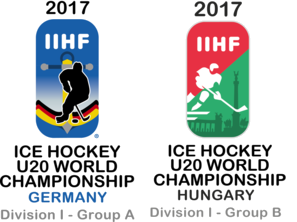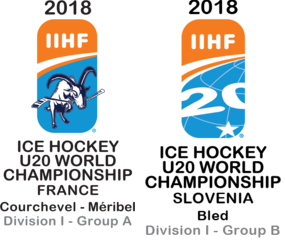
The 2012 World Junior Ice Hockey Championship Division I was a pair of international ice hockey tournaments organized by the International Ice Hockey Federation. In 2012, a new format was introduced to the IIHF World Junior Championships, therefore Division I A and Division I B now represent the second and third tiers of the IIHF World Junior Championship. Division I was played in two groups of six teams each. In each group, the first-placed team was promoted to a higher level, while the last-placed team was relegated to a lower level. This year, for the first time, the winner of Group B was promoted to Group A and the winner of Group A was promoted to the next year's Top Division. Previously, the winners of both groups were promoted to the Top Division.

The 2012 World Junior Ice Hockey Championship Division II was a pair of international ice hockey tournaments organized by the International Ice Hockey Federation. In 2012, a new format was introduced to the IIHF World Junior Championships, therefore Division II A and Division II B now represent the fourth and fifth tier of the IIHF World Junior Championship. Division II was played in two groups of six teams each. In each group, the first-placed team is promoted to a higher level, while the last-placed team is relegated to a lower level. This year, for the first time, the winner of Group B is promoted to Group A and the winner of Group A is promoted to the next year's Division I. Previously, the winners of both groups were promoted to the Division I.

The 2013 IIHF World U20 Championship was the 37th edition of the Ice Hockey World Junior Championship (WJC). It was hosted in Ufa, Russia. It began on December 26, 2012, and ended with the gold medal game played on January 5, 2013. The United States defeated defending-champion Sweden 3–1 to win their third title, their first one since 2010. American goalie John Gibson was named MVP of the tournament.

The 2015 World Junior Ice Hockey Championships was the 39th edition of Ice Hockey World Junior Championship, played from December 26, 2014 to January 5, 2015. It was co-hosted by Toronto, Ontario, and Montreal, Quebec, Canada, and organized by Hockey Canada, Hockey Quebec, the Ontario Hockey Federation, the Montreal Canadiens, Maple Leafs Sports and Entertainment and Evenko. Games were split between Air Canada Centre in Toronto and Bell Centre in Montreal, with Montreal hosting Group A matches and two quarter finals, and Toronto hosting Group B, along with the relegation games, two quarter finals, along with the semi-finals, bronze medal, and gold medal games.

The 2013 World Junior Ice Hockey Championship Division I was a pair of international under-20 ice hockey tournaments organized by the International Ice Hockey Federation. In each of the two groups, six teams played a round-robin tournament; the first-placed team was promoted to a higher level, while the last-placed team was relegated to a lower level. Divisions I A and I B represent the second and third tier of the World Junior Ice Hockey Championships.

The 2013 World Junior Ice Hockey Championship Division II was a pair of international ice hockey tournaments organized by the International Ice Hockey Federation. Each of the two groups consisted of six teams; the first-placed teams were promoted to a higher level, while the last-placed teams were relegated to a lower level. Divisions II A and II B represent the fourth and the fifth tier of the World Junior Ice Hockey Championships.

The 2014 World Junior Ice Hockey Championship Division I was a pair of international under-20 ice hockey tournaments organized by the International Ice Hockey Federation. In each of the two groups, six teams played a round-robin tournament; the first-placed team was promoted to a higher level, while the last-placed team was relegated to a lower level. Divisions I A and I B represent the second and third tier of the World Junior Ice Hockey Championships.

The 2014 World Junior Ice Hockey Championship Division II was a pair of international ice hockey tournaments organized by the International Ice Hockey Federation. Each of the two groups consisted of six teams; the first-placed teams were promoted to a higher level, while the last-placed teams were relegated to a lower level. Divisions II A and II B represent the fourth and the fifth tier of the World Junior Ice Hockey Championships.

The 2015 World Junior Ice Hockey Championship Division I was a pair of international under-20 ice hockey tournaments organized by the International Ice Hockey Federation. In each of the two groups, six teams played a round-robin tournament; the first-placed team was promoted to a higher level, while the last-placed team was relegated to a lower level. Divisions I A and I B represent the second and third tier of the World Junior Ice Hockey Championships.

The 2015 IIHF U18 World Championship Division I was two international under-18 ice hockey tournaments organised by the International Ice Hockey Federation. The Division I A and Division I B tournaments represent the second and the third tier of the IIHF World U18 Championship.

The 2016 World Junior Ice Hockey Championship Division I was a pair of international under-20 ice hockey tournaments organized by the International Ice Hockey Federation. In each of the two groups, the participating teams played a round-robin tournament; the first-placed team was promoted to a higher level, while the last-placed team was relegated to a lower level. Divisions I A and I B represent the second and third tier of the World Junior Ice Hockey Championships. To be eligible as a "junior" a player couldn't be born earlier than 1996.

The 2017 World Junior Ice Hockey Championship Division I was a pair of international under-20 ice hockey tournaments organized by the International Ice Hockey Federation. In each of the two groups, six teams played a round-robin tournament; the first-placed team was promoted to a higher level, while the last-placed team was relegated to a lower level. Divisions I A and I B represent the second and third tier of the World Junior Ice Hockey Championships. To be eligible as a "junior" a player couldn't be born earlier than 1997.

The 2018 World Junior Ice Hockey Championship Division I consisted of two tiered groups of six teams each: the second-tier Division I A and the third-tier Division I B. For each tier's tournament, the first-placed team was promoted to a higher division, while the last-placed team was relegated to a lower division.

The 2018 World Junior Ice Hockey Championship Division II consisted of two tiered groups of six teams each: the fourth-tier Division II A and the fifth-tier Division II B. For each tier's tournament, the first-placed team was promoted to a higher division, while the last-placed team was relegated to a lower division.
The 2019 World Junior Ice Hockey Championship Division I consisted of two tiered groups of six teams each: the second-tier Division I A and the third-tier Division I B. For each tier's tournament, the first-placed team was promoted to a higher division, while the last-placed team was relegated to a lower division.
The 2020 World Junior Ice Hockey Championship Division I consisted of two tiered groups of six teams each: the second-tier Division I A and the third-tier Division I B. For each tier's tournament, the first-placed team was promoted to a higher division, while the last-placed team was relegated to a lower division.
The 2022 World Junior Ice Hockey Championship Division I consisted of two tiered groups of six teams each: the second-tier Division I A and the third-tier Division I B. Due to the exclusion of Russia and Belarus, the following changes in promotions and relegations were made: Latvia as the second-placed team of Division I A were promoted to the 2022 Top Division, their second Junior World Championship tournament this season. In Division I B, the top two teams were promoted to the next year's Division I A. In both tournaments, no team was relegated to a lower division.
The 2022 World Junior Ice Hockey Championship Division II consisted of two tiered groups of six teams each: the fourth-tier Division II A and the fifth-tier Division II B. Due to the exclusion of Russia and Belarus, the following changes in promotions and relegations were made: The top two teams were promoted to a higher division and no team was relegated to a lower division.
The 2023 World Junior Ice Hockey Championship Division II was a pair of international ice hockey tournaments organized by the International Ice Hockey Federation. It consisted of two tiered groups of six teams each: the fourth-tier Division II A and the fifth-tier Division II B. For each tier's tournament, the first-placed team was promoted to a higher division, while the last-placed team was relegated to a lower division.
The 2024 World Junior Ice Hockey Championship Division I competitions were two international under-20 ice hockey tournaments organized by the International Ice Hockey Federation. It consisted of two tiered groups of six teams each: the second-tier Division I A and the third-tier Division I B. For each tier's tournament, the first-placed team was promoted to the next higher division, while the bottom-placed team was relegated to a lower division.














